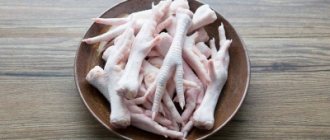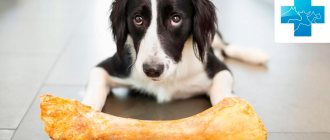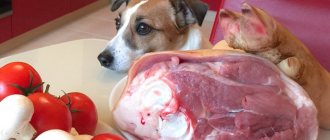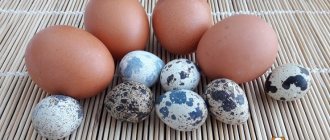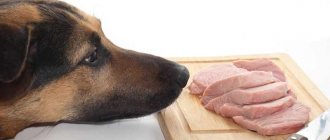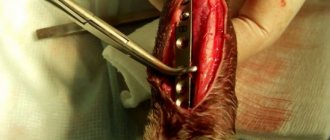Domestic dogs are carnivores by nature. As a rule, their diet is dominated by foods of animal origin. Relatives of dogs, like wolves or jackals, having caught prey, eat its body without a trace. All components of the body are favorable as food for predatory species of animals, and therefore their domesticated comrades happily eat meat dishes and crack bones. Nevertheless, the debate about the usefulness of bones in the pet menu still does not end. Many owners are especially interested in whether they can give their dogs chicken bones.
Why do dogs love to chew bones?
For all dogs, chewing small and large bones is undoubtedly a natural action that is preferred by individuals of various breeds. This process allows predatory animals to scratch the gums and remove plaque from the teeth. This skill has been developed over quite a few centuries, and the best confirmation of this is the strong jaws of dogs. The hard remains of the carcass play the role of natural exercise equipment and often replace products for games. Most likely, a well-fed and satisfied animal will blissfully nibble on a delicious delicacy. But is it possible for a dog to eat whole carcasses, including bones? And what bones can be given to dogs.
Can dogs be given chicken bones?
Previously, it was believed that you could give your dog chicken bones. This food product was healthy and was recommended by dog breeders for dogs of various breeds. It was assumed that such food included many beneficial substances, such as magnesium, calcium and other minerals required for the body of a pet. This food was consumed to strengthen the fangs. However, in our time, the experts’ point of view on this product has changed. Veterinarians warn current pet owners that dogs should not be allowed to eat chicken bones, there are several important factors.
A distinctive feature of bird bones from animal bones is that they are usually hollow in the middle. The presence of voids in the bones makes it possible to reduce the mass of the entire skeleton, which in turn is required for the ability to fly. At the same time, the bone tissue is compacted, quite hard, but very fragile. When a dog chews chicken bones, they crumble into many tiny and very sharp pieces, which can greatly harm the health of the pet.
It is strictly forbidden to feed chicken bones left over from dinner to domestic dogs.
A negative result can befall your pet at any moment, here’s what can happen:
When a dog frequently chews on bones, the teeth are worn down and worn down, and the enamel of the teeth deteriorates.
Teeth can break from gnawing hard bones, which subsequently leads to caries or pulpitis. Without a suitable course of treatment, the loss of both the broken tooth and those located nearby is likely.
Due to the sharp ends of the bones, the mucous membrane of the mouth can rupture, which in the future will lead to diseases such as stomatitis and periodontal disease.
Chicken produced by large poultry farms can give rise to diseases for dogs. This is explained by the fact that broilers in such agricultural enterprises move little. Often they develop various inflammations that affect the bone tissue. They do not harm people, since people do not eat this product. With living creatures the situation is different. If your pet eats chicken bones that are contaminated, they are likely to get the infection and become sick. In particular, feeding with thermally unprocessed foods is dangerous in this matter: wings, paws, drumsticks.
Injury to the trachea and larynx also often occurs, and the four-legged friend experiences piercing pain.
You should not give chicken bones to dogs, as fragments can get stuck in the digestive tract, which can lead to asphyxia.
It is likely that parts of the bones may get stuck in the colon or anus, which will certainly lead to constipation. But there is also a possibility of disruption of the passage of contents in the intestines, which means poisoning of the entire body.
Penetrating damage to the walls of the stomach or intestines. The contents of the organs penetrate into the abdominal cavity, and the dog experiences terrible pain, nausea and vomiting, and the abdomen swells. The pet needs immediate help. The animal's condition is critical, requiring emergency surgery, otherwise the dog may die.
Small chicken bones found in the wings and legs are considered especially unsafe. The tubular hollow bone of any birds is prohibited for feeding dogs, even large ones such as a goose or turkey, for the reason that the bones are similarly pricked into sharp, dangerous parts.
However, if you think that you can give your dog chicken bones, then you should know that the pointed ends of the bones will still cause damage to the dog’s health.
What should I feed them instead?
As is already clear, it is better not to give chicken bones to your dog. What can replace them with? First of all, you need to know that giving up bones is not at all necessary. They can be given during teething periods (up to approximately 6.5 months), and sometimes to adult animals.
But you need to choose the right seeds. They should not have sharp edges; they should have meat or cartilage on both sides. The best option is raw beef bones. After your pet chews on the cartilage, it is recommended to pick up the bone so that the animal does not chew it completely.
As an alternative, you can use artificial chewing bones , consisting of skin, cartilage, and tendons. They will completely satisfy the animal’s need to chew something. Various toys can also be used: rubber bones, ropes.
As for chicken specifically, it is still a source of a number of substances valuable for the animal, and can be present on the pet’s menu. Acceptable options for its use are as follows:
- You can make broth using chicken frames , removing the bones before adding cereal or vegetables. It is not recommended to use chicken skin in broth, especially when it comes to factory-processed poultry.
- When cooking, you can add chicken cartilage .
- necks minced into mince are useful .
- It is allowed to use chicken by-products .
As for chicken paws , opinions differ. They consist of tubular bones, which can be dangerous. The best option is to give paws in the form of jellied meat, which is especially useful for puppies and can become a replacement for industrial chondroprotectors.
Chicken heads may be used . When raw, they need to be cut into several parts and combined with porridge or vegetables. There are no tubular bones in the heads that are dangerous for pets. However, it is better to remove the beaks - they are not digested and do not provide any benefit. If the dog ate heads with beaks, belching is possible.
My dog has a bone stuck, what should I do?
If your dog does swallow a chicken bone, it is recommended to carefully monitor it for a certain period. As soon as the pet begins to scratch its face and begins to drool heavily, it is necessary to completely examine its oral cavity.
The following are the first symptoms of a stuck chicken bone. When you notice a foreign object, carefully pull it out with tweezers. If your gums are injured, be sure to disinfect the injury with an anti-inflammatory agent. If you cannot remove the bone on your own, immediately go to a veterinary clinic.
In the worst case scenario, the bone can pierce the throat or cut the food and intestinal tract. If a bone gets stuck in the throat, the pet will try to cough up. In this matter, the help of a professional is similarly required. If the intestines or esophagus are injured, emergency surgical care is required.
The presence of a stuck bone in the stomach or intestines is indicated by the following signs:
- coughing and wheezing;
- head shaking;
- scratching the face with a paw;
- intense salivation;
- difficulty breathing (it seems that the animal is breathing heavily and repeatedly, at the same time, in the most difficult situations, oxygen does not enter the dog’s lungs);
- gums have a grayish color;
- Sometimes fainting and even clinical death occur, the dog’s breathing stops.
Keep in mind that a dog with a stuck bone will be very worried and nervous, and even in the absence of other indicators, scared behavior means serious problems.
Possible dangerous consequences
When a dog eats bones, it chews them into small pieces. But it is very difficult for the body to digest them. A semi-digested porous mass accumulates. The consequence is difficulty in excreting feces and the appearance of blood. If the bones continue to be absorbed in the same quantity, the intestines become clogged. If you contact a veterinarian in time, you can get by with a deep enema and a laxative. Then you will need a strict diet.
If the blockage is so large that it cannot be washed out, or there are several foci, there is only one way out - surgery. An ultrasound will show everything. In a critical case, necrosis of the intestinal wall may occur due to circulatory problems. This applies to everyone, even dogs of the largest breeds. If the outcome of the operation is favorable, rehabilitation lasts quite a long time.
It is much more dangerous when a sharp piece of bone pierces the intestines or stomach, and sometimes in several places (the intestines are laid out in loops). The likelihood of peritonitis is very high. Surgery is inevitable. Treatment will include very powerful antibiotics.
Older dogs may have dental problems. Bones carry a high load on them.
A pet can also choke on a piece of bone, but this happens extremely rarely.
Can dogs be given chicken wings?
It is strictly forbidden to feed your dog chicken wings, especially those with bones. In the wings of chickens, as well as in the legs, the bones are tubular, which, in addition to the rest, have a small amount of bone substance, and therefore the bones are empty inside. Therefore, because of this feature, chicken wing bones, just like thigh bones, are considered the most dangerous for pets.
When chewed, the bones split in length. The resulting sharp, thin, needle-like pieces effortlessly pierce the walls of organs, damaging the esophagus and intestinal tract, and ultimately lead to severe internal bleeding in the dog with the formation of severe health problems.
In addition to dangerous bones, chicken wings mainly contain animal fat, and the protein content is low. Animal fat is poorly digested in the dogs’ stomach, and also increases the workload of the liver, which can ultimately cause inflammation. Large amounts of fat in a dog's diet can lead to obesity, especially in breeds of dogs that are prone to this disease, such as the French bulldog.
For this reason, eating chicken wings as a treat is not advisable. It is better to offer your dog chicken necks, heads or legs that have been pre-frozen. These by-products harmlessly clean the dogs’ fangs and massage the dogs’ gums, and they also contain a sufficient amount of mineral elements and vitamins. This treat is especially beneficial for your puppy's health during teeth replacement. How to brush your dog's teeth at home?
In what form can it be given?
It is not enough just to choose bones that are safe for your pet. You need to know in what form they can be used for feeding.
Are boiled bones allowed?
Boiled chicken bones are not digested in the stomach and cause constipation.
During heat treatment, all beneficial substances are destroyed. Boiled bones do not contain anything nutritious in their composition. They settle in the intestines and gradually accumulate, which leads to a deterioration in the dog’s condition.
Is it possible to give raw
The best option would be raw heads or necks.
To destroy pathogenic microorganisms, it is recommended to pour boiling water over offal. This way you can protect your pet from infection.
Bone minced chicken
It is prepared by chopping boiled bones and adding poultry meat. The finished product can be given to animals in small portions maximum three times a week. Its more frequent use leads to the accumulation of meat and bone mass residues in the intestines.
This food is often mixed with porridge and chopped vegetables. As a result, intestinal peristalsis improves, and undigested particles of minced meat are quickly eliminated from the animal’s body.
Is it possible to give puppies chicken bones?
You should not feed bones to puppies, as this is unsafe for their health. The mucous membrane of puppies is quite sensitive and delicate, and therefore the gastrointestinal tract is very easy to injure. Hard bones damage the enamel of teeth when chewed and form an incorrect bite.
As mentioned earlier, you are only allowed to feed the puppy with chicken neck or head. Offal should be included in your pet's menu from the age of four months. It is enough to feed the animal a new product once a week. The most frequent use of the product in the diet of a young dog can adversely affect the health of the kitten.
Veterinarian recommendations
As for this product, the opinion of veterinarians is somewhat different. Some of them allow it in food, others are against it.
In general, when choosing this product, it is recommended that the animal take into account the following recommendations:
- Give preference to raw beef moss.
- Supervise small breed dogs and puppies while they chew the product.
- Do not introduce boiled bone waste into the diet, especially after jellied meat.
- Beef ribs with cartilage will be the choice for puppies.
- It is strictly forbidden to allow chicken and pork bones to be chewed.
- For oral care, it is better to use industrial bones.
Important! Many cases of ruptured internal organs demonstrate why dogs should not be given tubular bones. Their sharp fragments can cause irreparable harm to health.
Optimal dog nutrition should include solid foods.
Safe bones for dogs
In pet stores, especially in online stores, you can buy well-processed or artificial substitutes for natural cartilage. This treat will serve as a wonderful alternative to natural bones, not only for a dog that eats exclusively dry food, but also for a pet on a natural diet. Is it possible to feed a dog dry and natural food at the same time? Every owner should know. Manufacturers produce all kinds of artificial bones that do not harm the health of your four-legged pet. The range includes the following types:
- Chewable edible bones are typically made from chicken meat that is wrapped in tough beef skin. The pet chews the chewing bone for a long time until it eats it completely.
- Calcium bone with pieces of meat, made from rice, potato flour and corn starch. Contains calcium phosphate, which is beneficial for dog tooth enamel.
- Tendon bones. Bone from dry veins massages the gums well and cleans the teeth; it is not recommended to use the product very often.
When purchasing an artificial bone, you need to find the appropriate product for your pet dog. The size of the bone must be commensurate with the size of the animal, that is, when purchasing a product, you must take into account the breed of the dog. Miniature cartilage can cause asphyxia in a large dog, and a huge bone made from tendons can ruin the teeth of a toy dog.
Briefly about the main thing
- Chicken bones injure the internal organs of dogs, which can cause the death of a pet;
- There are no nutrients in the bones; they will not satisfy your hunger;
- An adult dog should not constantly chew on something;
- A dog can brush its teeth with treats or toys from a pet store;
- Beef and pork bones are included in the permitted list;
- Allowed foods can only be given raw;
- Turkey, rabbit and fish are just as harmful as chicken;
- First aid is the “candle method”: wax “neutralizes” sharp corners;
- If you see blood in your vomit or feces, call your veterinarian.
